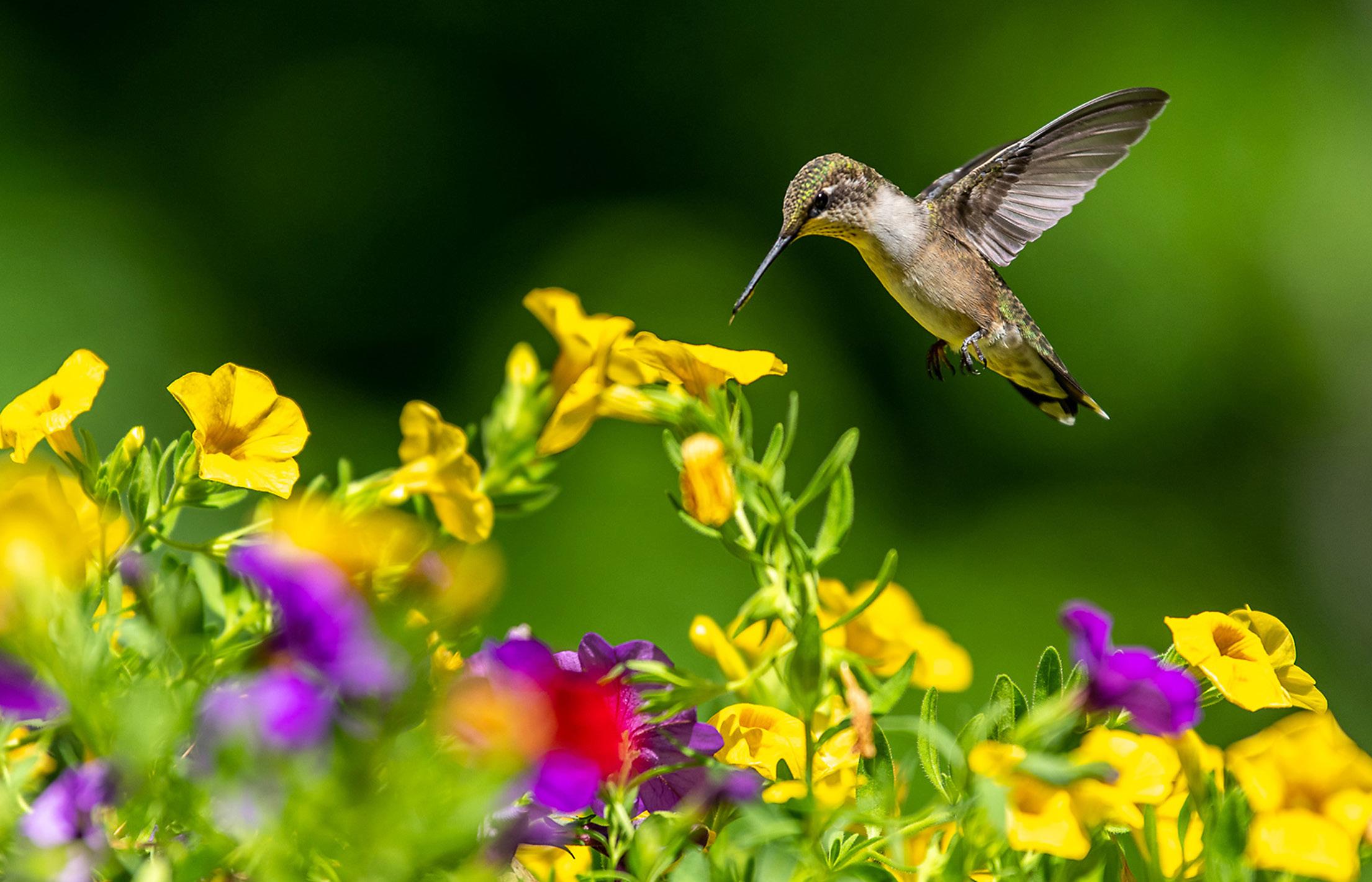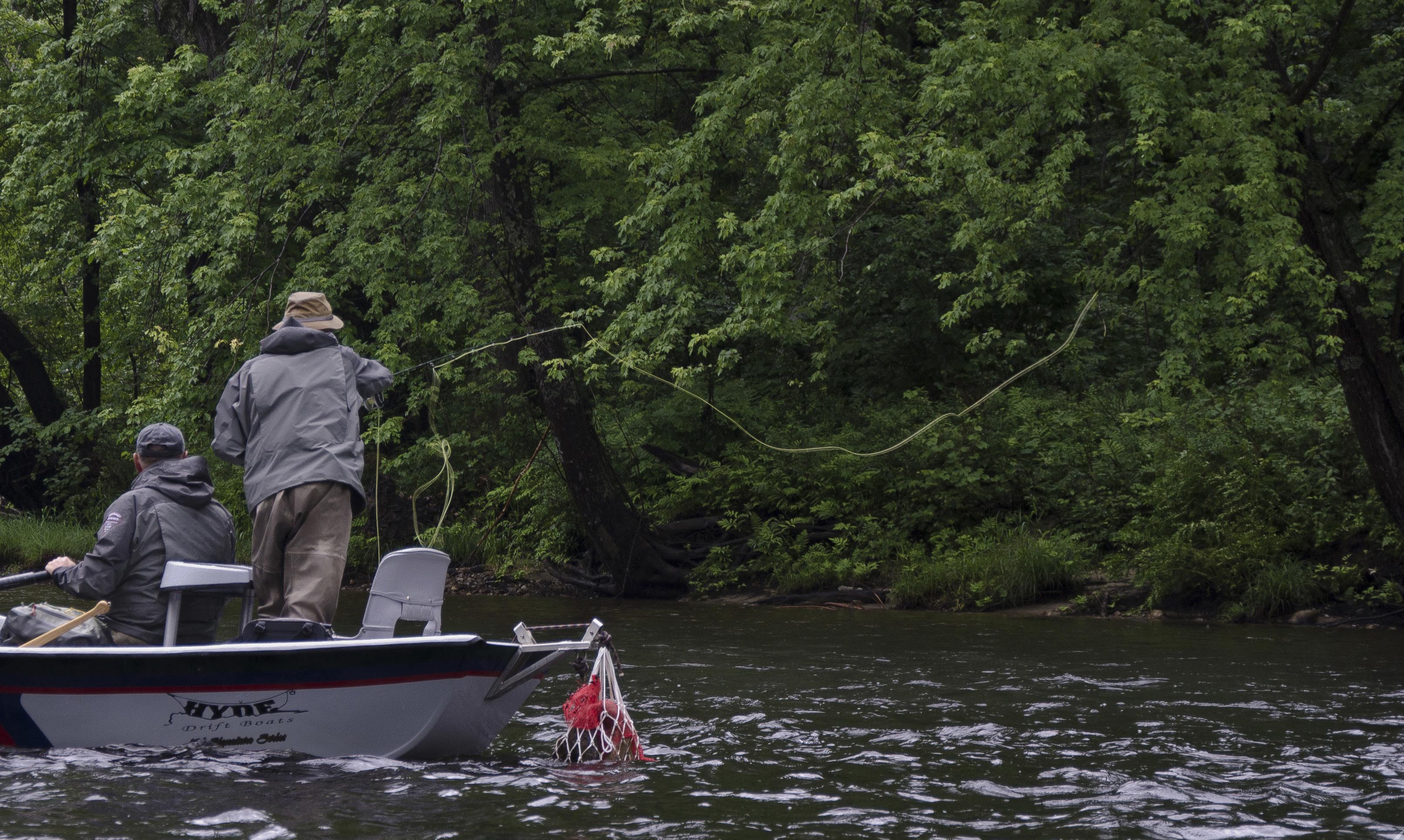
12 minute read
ALDER FLIES ON THE ANDROSCOGGIN RIVER
THE MOST ICONIC HATCH IN THE EAST Alder Flies on the Androscoggin River By Dominic Lentini
Windows down and drift boat in tow, we drove through Pinkham Notch. It was one of those lucky days when our boss let us leave work early to fish the evening hatch. I tried to focus while sitting at my desk, but, trout.
One hour and 20 minutes later we put the boat in the water. Next, the rods went in the boat. Then, food and gear was stowed away. Our most important cargo? Carter’s 13-year-old chocolate lab, Camo. No one loves fishing more than him.
We tied on dry flies. It’s what we were there to fish. But we were a few days too early for the hatch we wanted. No flying bugs and no takers from below. Maybe a wet fly under the surface? Joe’s line went tight within minutes. After he released a beautiful little rainbow, he wasted no time landing two more. Then, my line went tight—but only for a few seconds. A bad hookset. It happens. After the fourth one, though, it becomes frustrating.
Determined to break my streak of missed fish, I lined up a perfect cast. It was that rare moment when your line does exactly what you were asking. Landing in a pocket the size of my bathroom sink, it immediately went tight. After a strong tug, I knew it was a big fish. Despite the best efforts of my drag, the fish ran straight downstream when Carter dropped anchor. Then, the line went slack. It goes like that sometimes.
Running from Errol, New Hampshire for 178 miles until it joins the Kennebec River at Merrymeeting Bay in Maine, the Androscoggin River—specifically its upper section from Errol to Berlin—is regarded as one of the finest trout fisheries in the east.
Entomart photo

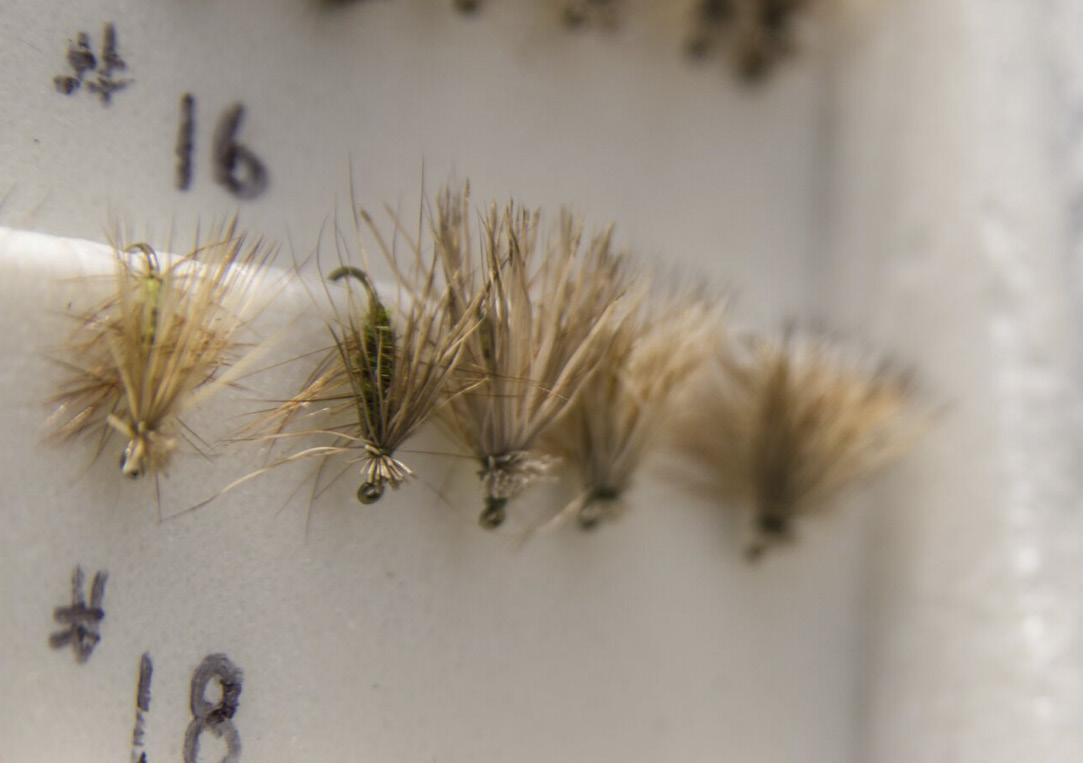

Unfortunately, it’s hypnotizing eddies, glassy tailouts, and fast riffles haven’t always seen the respect and care that they do now. A resource-based economy, Berlin, New Hampshire and the surrounding towns relied on the lumber and paper industry for over 150 years. This took a major toll on the river.
In the 1850s, recently invented water-powered turbines led investors to the Berlin area where they built sawmills along the Androscoggin. Every year until 1964, they used the river to float logs down to the mills in an annual log drive. It completely covered the surface of the water. As time passed and these mills diversified, they began processing pulp, chemicals, and paper, as Act of 1972 was developed. In the 48 years since then, action has been slow, but many of the mills have closed and the river has begun to heal. There’s still a great distance to go before the damage will be fully undone on the Androscoggin’s lower sections, if it ever will be at all. The river’s upper section, though— despite the detrimental effects of the annual log drives—remains a great fishery.
well. Employing many thousands of locals, they were crucial to the local economy, yet detrimental to the environment.
Not only did the mills dam the river, thus blocking the free movement of fish and other wildlife, but they also contaminated it with enormous quantities of waste. Uncontrolled for many years, the pollution became so bad that the Androscoggin was used as a key piece of evidence when the Federal Clean Water the windows down. The pollution would make us sick, but I was young enough that I didn’t grasp what that really meant. Now, with most of the mills gone, the smell remains nothing but a blurry memory.
Having spent my childhood making periodic trips to the Androscoggin, I’ve noticed this evolution myself. When I was younger, my family would pass through Berlin on our trip to the river’s upper reaches. We could never drive through town with
A wide, meandering river, the Androscoggin’s waters are home to brown trout, rainbow trout, brook trout, and landlocked salmon. While not sought after like their salmonid
Klementovich photo

counterparts, some of the slower stretches of river are also home to warm water species, such as bass, perch, and chain pickerel.
Fishable by drift boat or wading, many anglers spend their entire lives learning the intricacies of the river’s soft bends and deep pools. It should be noted that while some stretches of the river are open year round, many others are closed from October 16 through December 31 for the spawning season. So, at the start of the new year, each news season truly begins. With that said, January in New Hampshire has a reputation of being cold. Thus, while some of the more dedicated anglers brave the conditions to find fish in the early winter months, for most, the true fishable season doesn’t begin until April or May. That’s when things get exciting!
Nymphs, streamers, dries—anglers often try them all during a day fishing the Androscoggin. While the river is laden with caddis, mayflies, and stoneflies, it has become famous for the same bug that got us out of work early: the alder fly.
According to local guide and fishing legend Rick Estes, “The alder fly hatch is the most known hatch on the river because it’s so prolific.” He’ll tell you that it’s fairly schedulable as well. When the water temperature hits 66° and the purple irises are blooming—usually near the third week in June—the hatch is imminent. Once it arrives, it usually runs for between 10 days and two weeks of action

packed fishing from Errol to Berlin.
Carter Davidson—the man behind the oars when I couldn’t seem to hook a fish—states the anticipation is so strong that it’s almost as if the hatch starts in early June. When he walks into the fly shop, the first question is almost always, “Have you seen any alders yet?” Everyone’s ready and waiting for it.
Though it’s called an alder fly, it actually isn’t an alderfly (the proper spelling of the the actual alderfly) at all. Technically a caddis, they got their name from their habit of residing under alder trees. Also referred to as a zebra caddis, they’re much brighter and stouter than your typical caddis. What’s more, they have black antennae that can be nearly three times their body length.
When they first emerge, alder fly adults have ginger legs with dark green bodies. Often, as the hatch starts, there are so many bugs that you can see swarms of
According to local guide and fishing legend Rick Estes, “The alder fly hatch is the most known hatch on the river because it’s so prolific.” He’ll tell you that it’s fairly schedulable as well. When the water temperature hits 66° and the purple irises are blooming—usually near the third week in June—the hatch is imminent.
them from the road before you’re even on the river. If you shake a tree it will rain alder flies.
As the hatch progresses, the alders darken to black with yellow banding when they return days later to lay their eggs. On this return trip, the female alders dive from the sky and splash into the water where they lay their eggs, often drowning. Because they’re stuck and an easy target, the fish eat more adult alders at this stage in the hatch. In fact, Estes says that it’s easier to fish at this point. Initially, “It can actually be tough to fish because there are so many natural bugs in the water. But by the time they’re returning, there aren’t so many at once.”
In order to be prepared for the hatch, anglers should have both light- and
Courses include Wilderness First Responder, EMT, Wilderness EMT, Advanced EMT, Wilderness Medicine Bridge Course, Wilderness First Aid, and more.


thekaneschools@gmail.com THEKANESCHOOLS.COM
KNOW YOUR REGULATIONS
In most cases, the New Hampshire river fishing season runs from January 1 to October 15, but some areas have additional designations that you need to know. You should always check before you head out to fish. Visit www.wildlife.state.nh.us/fishing/seasons.html
Notable designations for the Androscoggin River
• Landlocked salmon may not be taken from any body of water after September 30 and before April 1.
Errol to the markers at the dead water at Bragg Bay is fly fishing only with a two-fish, minimum length 12 inches, bag limit.
From the Dummer-Cambridge Town line to Pontook Dam is open yearround, except for salmon.
From Berlin to Shelburne has no closed season for all species. It’s catch-and-release only with single barbless hooks and artificial flies.


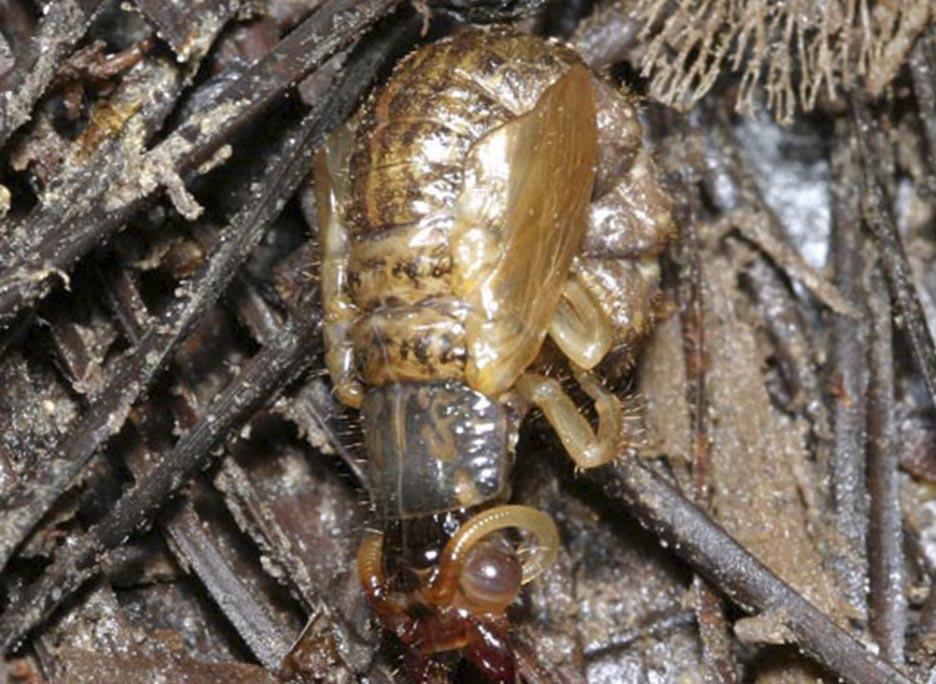

Larvae
After they hatch from eggs, alder larvae make underwater silk nets and gelatinous tunnels. Watch out, they’re extremely slippery! Typically, olive and brighter greens are great imitation colors.
Pupae
In early June, the alder larvae abandon their silk nets and tunnels and create rough casings. Once they grow enough, they break free and head for the surface. A darker green-bodied emerging alder pattern fished around rocks and riffles will serve you well in this stage.
Adults
Freshly emerged adults have ginger legs with dark green bodies, which soon darken to black with yellow banding when they return to lay eggs. Fished on the dead drift, both colors will be needed for the hatch.
Ryan Daniel Photography
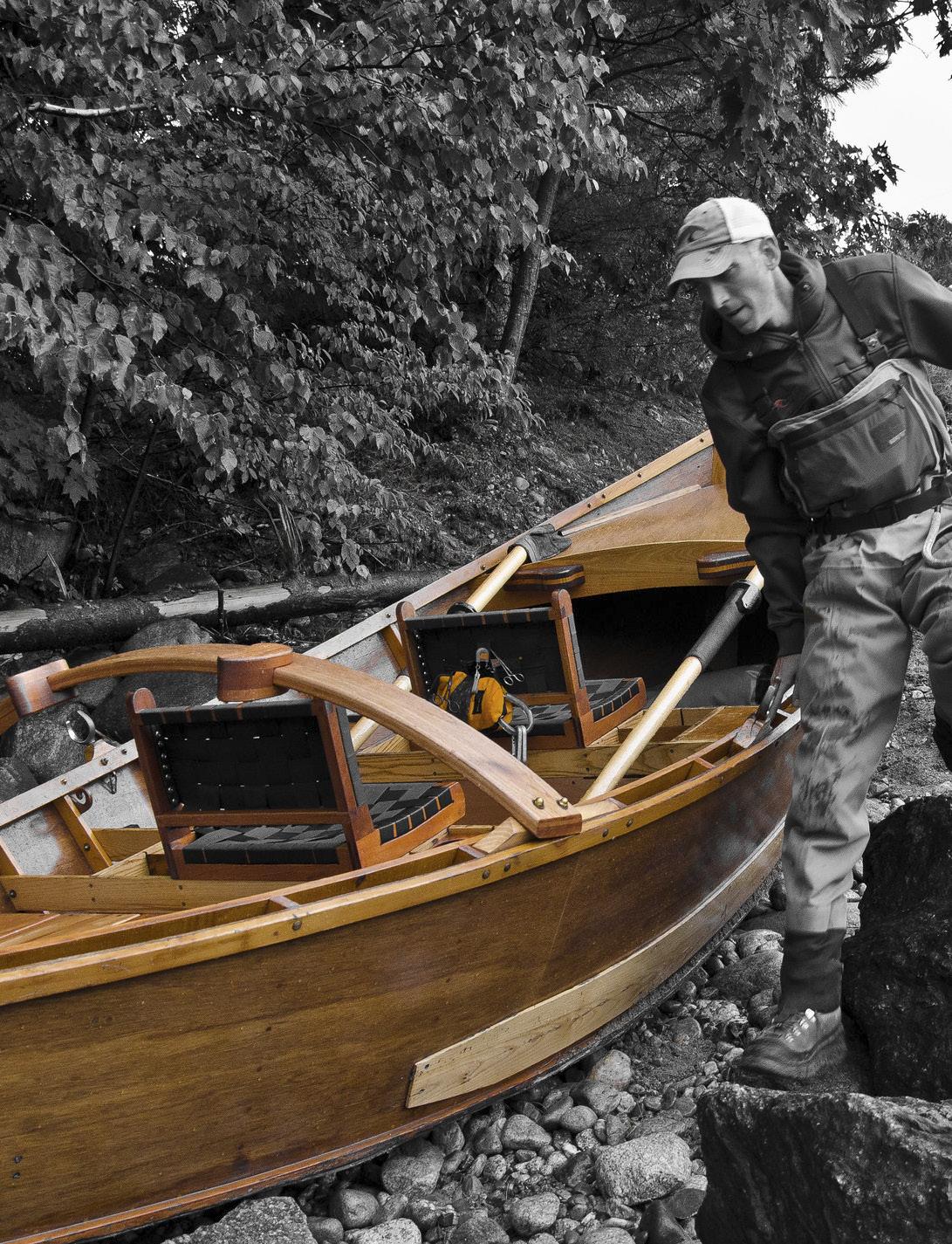
dark-bodied alder flies in their box. Size 12 is ideal. Presented on the dead drift, they’ll be quite effective. Earlier in the hatch, you can also add an alder wet fly as a dropper to your adult imitation. This is often effective as the trout don’t want to expand energy leaping after the alders as they fly into the air, instead preferring to rely on the easy subsurface meal of the emerging alders. If you arrive early to the hatch like we did, you’ll be happy you added it to your box. As an added trick, towards the end of the hatch you can present the darker-bodied returning
alder with a forceful cast, mimicking the action of a diving fly. Then, after the dead drift, you can even strip if briefly under water before letting it resurface.
For good reason, the alder hatch is famous for this two-week period of furious activity. “I’ve seen the hatch act as a turning point in a number of anglers’ careers,” Davidson noted. “It makes them totally fall in love with the sport. It’s that much fun.”
The action doesn’t have to end after those two weeks, though. Soon after being laid, the alder eggs hatch into alder larvae which live and grow in the rivers until they eventually repeat the cycle the following June. As a result, the Androscoggin is filled with alder larvae throughout the fall, winter, and spring fishing seasons. Whether picking them up in the rocks or catching them as they float by, the fish feed on these larvae
VISIT YOUR LOCAL FLY SHOP
Whether a veteran angler or first-timer, anyone can benefit from hiring a guide. Stop by one of your local shops for recommendations, more information, and to get the right flies in your box!
A. L.L. Cote
Errol, NH (800) 287-7700 www.llcote.com
B. North Country Angler
North Conway, NH (603) 356-6000 www.northcountryangler.com
C. Mountain High Fly
Lincoln, NH (603) 348-7447 www.mountainhighfly.com
C A
B
for most of the year. Alder larvae will make a great addition to your fly box.
Despite our carefully timed early release from work, we missed the hatch by a few days. However, we made up for it by fishing the pre-hatch alder pupae under the surface. I should say Joe made up for it, because I still managed to miss just about every fish I turned that night. I think I landed something eventually, but I was hardly able to save face.
Having spent hours on the river, we were fast approaching sunset. Since we could hardly see to cast, Carter began our 20-minute row to the takeout. But right as the light left us, we hit a hatch that’s arguably more famous than the alder: the mosquito.
I’ve lived in New Hampshire most of my life. I’m used to mosquitos. It’s part of living here. But this was like nothing we had ever seen before, and that’s not hyperbole. My legs, arms, face, ears—every piece of exposed skin—were plastered in them. I jumped up and down. I swung my jacket in circles. I wore a shirt for pants. I yelled. I curled up in a ball. I thought about casting, but it was impossible. It goes like that sometimes.
A few days later I was back to try to find some alders.
A special thank you to Hatch Guide for New England Streams, by Thomas Ames, Jr. for being one of the definitive sources on alder flies and a crucial source for this article. An additional thank you to Rick Estes and Carter Davidson for their guidance and knowledge throughout the writing process.
(603) 356-0039 · 2101 Wht Mtn Hwy, North Conway, NH Hours: Tuesday - Friday 9AM - 5PM Saturday 9AM - 4PM, Sunday 12PM - 4PM Closed on Mondays

Supporting the Non-Profit
GET OUT MORE




